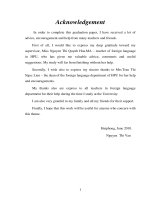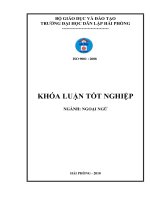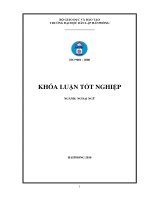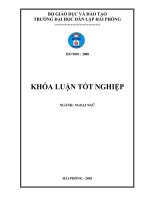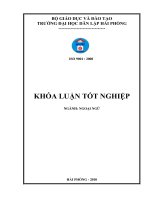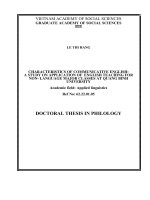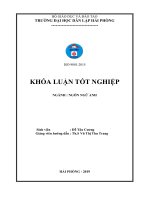Study on intonation of english questions
Bạn đang xem bản rút gọn của tài liệu. Xem và tải ngay bản đầy đủ của tài liệu tại đây (484.52 KB, 79 trang )
Acknowledgement
In order to complete this graduation paper, I have received a lot of
advice, encouragement and help from many teachers and friends.
First of all, I would like to express my deep gratitude toward my
supervisor, Miss Nguyen Thi Quynh Hoa.MA – teacher of foreign language
in HPU, who has given me valuable advice, comments and useful
suggestions. My study will far from finishing without her help.
Secondly, I wish also to express my sincere thanks to Mrs.Tran Thi
Ngoc Lien – the dean of the foreign language department of HPU for her help
and encouragements.
My thanks also are express to all teachers in foreign language
department for their help during the time I study at the University.
I am also very grateful to my family and all my friends for their support.
Finally, I hope that this work will be useful for anyone who concern with
this theme.
Haiphong, June 2010.
Nguyen Thi Van
1
TABLE OF CONTENT
PART ONE: INTRODUCTION ....................................................... 1
1. Rationale of the study .................................................................... 5
2. Scope of the study ......................................................................... 5
3. Aims of the study .......................................................................... 6
4. Methods of the study ..................................................................... 6
5. Design of the study ........................................................................ 7
PART TWO: DEVELOPMENT ....................................................... 8
CHAPTER 1: THEORETICAL BACKGROUND ........................... 8
1. An overview of English sentences .................................................. 8
1.1. What is an English sentence ? ................................................... 8
1.2. Classification of sentence ......................................................... 9
1.2.1. Statement............................................................................. 9
1.2.2. Questions........................................................................... 10
1.2.3. Commands ......................................................................... 10
1.2.4. Exclamations ..................................................................... 11
2. An overview of English question ................................................. 11
2.1. What is the question? .............................................................. 11
2.2. Classification of question ........................................................ 12
2.2.1. Yes-No questions ............................................................... 12
2.2.2. Wh-questions ..................................................................... 13
2.2.3. Alternative questions ......................................................... 13
3. Intonation .................................................................................... 14
3.1. What is intonation ? ................................................................ 14
3.2.The roles of intonation. ............................................................ 16
3.3. Intonation language and tone language .................................... 19
3.4. Function of intonation............................................................. 20
3.4.1. Grammatical function ........................................................ 20
2
3.4.2. Attitudinal function ........................................................... 22
3.5. Some major intonation features ............................................... 24
3.5.1. Stress ................................................................................ 24
3.5.1.1. Tonic stress .................................................................. 26
3.5.1.2. Emphatic stress ............................................................. 26
3.5.1.3. Contrastive stress .......................................................... 27
3.5.1.4. New information stress ................................................. 27
3.5.2. Tune shapes ....................................................................... 28
3.5.2.1. The Fall Tune-The Glide-Down ..................................... 29
3.5.2.2. The first rising tune –the Glide- Up ............................... 29
3.5.2.3. The rising tune-the Take-off .......................................... 30
3.5.2.4. The falling-rising tune-the Dive .................................... 30
CHAPTER 2: INTONATION IN ENGLISH QUESTIONS ........... 31
1. Intonation in English questions .................................................... 31
1.1. Yes-No questions .................................................................... 31
1.1.1. General Yes-No questions .................................................. 31
1.1.2. Tag questions .................................................................... 32
1.1.3. Declarative questions ......................................................... 34
1.1.4.Exclamatory questions ........................................................ 34
1.1.5.Rhetorical questions............................................................ 35
1.2. Wh-questions .......................................................................... 35
1.3. Alternative questions .............................................................. 36
1.3.1. Common Alternative questions ........................................... 37
1.3.2. Alternative plus Yes-No questions ..................................... 37
1.3.3. Alternative plus Wh-question ............................................. 39
2. Attitudinal functions of the intonation and English question s ...... 39
2.1. Yes-No questions .................................................................... 39
2.1.1. The High Drop ................................................................... 39
2.1.2. Low-Bounce ...................................................................... 40
3
2.1.3. The Take-off ...................................................................... 41
2.1.4. The Switchback ................................................................. 42
2.1.5. The Low Drop ................................................................... 43
2.2. Wh-questions .......................................................................... 45
2.2.1.The High Drop .................................................................... 45
2.2.2. Low Bounce ...................................................................... 46
2.2.3. The Take-off ...................................................................... 48
2.2.4. The Switchback ................................................................. 49
2.2.5. The Low Drop ................................................................... 50
2.3. Alternative questions .............................................................. 51
CHAPTER 3: FINDING AND DISCUSSION ON THE STUDY .. 53
1. Finding and discussion on using intonation of English questions of
English students .............................................................................. 53
2. Some suggestions from improvement after studying intonation ..... 59
2.1. For competence enhancement .................................................. 59
2.1.1. Improving English listening ............................................... 59
2.1.2. Improving English speaking ............................................... 61
2.2. For teaching English questions ................................................ 63
2.2.1. Wh-question ...................................................................... 64
2.2.2. Yes-No question ................................................................ 65
2.2.3. Alternative questions ......................................................... 66
2.3. For communication purpose .................................................... 67
2.3.1. In Wh-question .................................................................. 67
2.3.2.In Yes-No questions ............................................................ 69
2.3.3. In Alternative questions ..................................................... 71
CONCLUSION .............................................................................. 73
REFERRENCES:
APPENDIX
4
PART ONE: INTRODUCTION
1. Rationale of the study
Language is an essential means of communication in our life. Thanks to
language, people are able to decode the messages, the ideas or any piece of
thought. Moreover, it is common knowledge that English is the most popular
language in the world. Nowadays, with the development of advance
technology and information, English plays an important role in society and it
is the main language to tighten relations between people in the global. So
learning English is getting more and more important in our society.
Of course, English learners know that intonation is very important because
inaccurate intonation causes the bad effects in communication. May be
sentence what you speak, you used different intonation, listeners can
understand it is impolite or polite, informal and formal …even when you
speak truly on grammar, vocabulary but listener still don’t understand what
you say because your intonation do not express any significances. Therefore, I
went to ask so many English learners as a foreign language. However, what I
received was that “It is important”, but little more.
Being a student of English, I am too stuck in the problem and my desire is to
make it clear and to get more comprehensive and specific understanding.
2. Scope of the study
Intonation is a large theme because every country has its own language and of
course, every language has it own intonation. However, due to limited time
and knowledge in this paper, I only focused on the part of intonation of
English question (wh-questions, yes-no questions and alternative questions, in
which .definition, difference between tonal language, and intonation
5
language, intonation patterns, some major intonation features, the links
between those intonation patterns and speaker’s attitude will be mentioned.
3. Aims of the study
Being aware of the fact that intonation is an extremely difficult topic and
merely well-understood by foreign English learners and every native speakers
of English who take the intonation for granted, however, appreciate the
intonation associated to attitude of the speakers. Therefore, when they hear
foreign grammatical or pronunciation mistakes, they are quite willing to
accept and understand them. However, if inappropriate intonation is used
then, they might, without really knowing why, take offence and feel that this
person sound bored, arrogant or not interested in them. Therefore, I research
this topic with the following major aims:
Giving the knowledge of sentences, questions and intonation
Explaining the difference between tonal language and intonation
language
Distinguish different kinds of sentence questions.
Raising the learner’s aware of the existence of intonation and the
effects using intonation and communication.
Helping the learners use right intonation in right situations…
4. Methods of the study
With the above aims, the following methods are used in the studying process:
Having discussion with supervisor, friends, etc
Reading reference books and documents
Accessing Internet
Selecting typical examples
6
5. Design of the study
This paper provides a clear organization consisting three main parts that help
an easy exploration and practical benefits gained for readers as well.
Part one is the Introduction which includes: Rationale, Scope of the study,
Aims of the study, Method of the study, and Design of the study.
Part two is the Development which consists of three chapter as following:
Chapter 1 is the theoretical background deal with an overview of English
sentence, question, roles of intonation, difference between tonal language and
intonation language, functions of intonation and some major intonation
features.
Chapter 2 is intonation in English questions. It is divided into 2 parts:
intonation in English question and attitudinal functions of intonation and
English question.
Chapter 3 is the implication of the study which consists of 2 parts: finding and
discussion on using intonation of English question of English students some
and suggestions for improvement after studying intonation.
7
PART TWO: DEVELOPMENT
CHAPTER 1: THEORETICAL BACKGROUND
1. An overview of English sentences
1.1. What is an English sentence ?
So far, we have referred to sentences without providing any definition of a
sentence. The question “What is a sentence?” is more difficult than it might
appear. An American linguist, C.C Fries, counted more than two hundred
definitions of the sentence. The sentence is the basic building block of
written language. In the past, sentences were often defined according to their
meaning. For example, they were said to contain “a complete thought”. This
raises all sorts of questions about the difference between the complete
thought and an incomplete one.
A common definition today is: “A sentence is marked by a capital letter at
the beginning and a full-stop at the end”. This works for many English
sentences, but there are many languages, such as those in Asia that does not
use this punctuation .Also, it is possible to have written sentence without
capital letters and punctuation marks.
In traditional school grammar, a sentence is said to contain a subject and a
predicate: a major classroom occupation was analyzing sentences into
subjects and predicates. (the predicate is all the rest of the sentence after
subject)
Subject
Predicate
He
plays football.
8
He
plays football well yesterday.
“Each sentence is an independent linguistic form, not including by virtue
of any grammatical construction in any larger linguistic form”
(Leonard Bloomfield (1926:9)
1.2. Classification of sentence
1.2.1. Statement
Statements are sentences in which the subject is always present and generally
precedes the verb.
(Bandolph Quick Sidney Greenbaum(2000:190)
This is the sentence type mainly used and described by the forms: SV, SVO,
SVC, SVA, SVOA, SVOC, SVOO.
Eg:
The man
is coming.
S
V
I
bough
a house.
S
V
O
He
looks
tired.
S
V
C
He
was
at the desk.
S
V
A
9
She
led
them
upstairs .
S
V
O
A
We
elected
him
president of the company.
S
V
O
C
We
gave
her
a doll .
S
V
O
O
The function of statements is to convey information
1.2.2. Questions
Question is a kind of sentence, which is formed with subject operator
inversion together with a rising intonation, or the placement of wh-words at
the beginning, which is used to ask for agreement or for information.
Bandolph Quick Sidney Greenbaum(2000:199)
These are also referred to as interrogative sentences or interrogatives.
Eg:
Is she a teacher ?
What’s your name ?
There are three main types of questions:
Yes-No questions
Wh-questions
Alternative questions
1.2.3. Commands
10
Commands are sentences which normally have no overt grammatical subject,
and whose verb is in the imperative.
This type of sentence used to express suggestion, order, request or invitation.
It carries the falling intonation.
(Randolph Quick Sidney Green Baum (2000:190)
Eg:
Sit down, please!
Be quite!
1.2.4. Exclamations
Exclamations are sentences, which have an initial phrase introduced by
“what” or “how”, without inversion of subject and operator.
This type of sentence used to express feelings such as compliment, surprise,
attitude or opinion.
It carries the falling intonation
(Randolph Quick Sidney Green Baum (2000:190)
Eg:
What a naughty boy he is!
How well everyone played!
2. An overview of English question
2.1. What is the question?
Questions are sentences marked by one or more these three criteria:
- The placing of the operator immediately in front of the subject.
Eg : Will John speak to the boss today?
- The initial positioning of an interrogative or Wh-element.
11
Eg: Who will speak to the boss today ?
- Rising intonation
Eg: You will speak to the boss ?
(Randolph Quick Sidney Green Baum (2000:190)
2.2. Classification of question
2.2.1. Yes-No questions
Yes-No questions are usually formed by placing the operator before the
subject and giving the sentence a rising intonation.
Eg: Has the boat left ?
If there is no item in the verb phrase that can function as operator, “do” is
introduced as with negation.
(Randolph Quick Sidney Green Baum (2000:191)
Eg:I like coffee ~ Do you like coffee?
Again as wit negation, lexical “be” acts as operator; in BrE as this is often
true or “have” also informally “got” is added.
Eg: John was late ~ Was John late ?
He has a car ~ Does he has a car ? (esp AmE)
Has he got a car ? (esp BrE)
There are five main types of Yes-No question:
General Yes-No question
Tag question
Declarative question
Exclamatory question
Rhetorical question
12
2.2.2. Wh-questions
Wh-questions are formed with the aid of one of the following interrogative
words(or Q-words): who , whom, whose, what, which, when, where, how,
why.
(Randolph Quick Sidney Green Baum (2000:195)
As the rule:
(1) The Q-element (i.e. clause element containing the Q-words) generally
comes first in the sentence.
(2) The Q-words itself takes first position in the Q-element
Eg : Who opened my letter ?
(Q-word)
How many people are there in your family ?
(Q-element)
Wh-question carries the falling intonation and generally has subject operator
inversion.
2.2.3. Alternative questions
Alternative questions can be formed with the subject operator inversion
together with at least two options to be chosen which are coordinated by “or”
with or without use of “Wh-word”.
There are two types of alternative questions, the first resembling a Yes-No
question.
13
Eg: Do you like oranges or apples ?
The second resembling a wh-question
Eg: Which countries do you like to travel? Australia or England ?
3. Intonation
3.1. What is intonation ?
There is no language in the world, which would be regarded as entirely
monotonous. In the process of speaking, a syllable, a word, a sentence is
pronounced with the variation in pitch. Only in very unusual situations, we
speak with a pitch of the voice, which does not change. Various approaches to
a definition of intonation, which appeared through out the history, tried to
present a precise explanation of intonation. However, according to Peter
Roach (1991, p.133) there is no completely satisfactory definition of
intonation, but any attempt at a definition must recognize that the pitch of the
voice plays the most important part.
Firstly, intonation is about how we say things, rather than what we say.
Without intonation, it is impossible to understand the expressions and
thoughts that go with words. Listening to somebody speaking without paying
attention to the words: the “melody” you hear is the intonation.
Secondly, intonation is also the system of levels (rising and falling) and
variations in pitch sequences within speech.
Thirdly, in English Dictionary – with Multi- Lingual Search, noun intonation
has four definitions:
The rise and fall of the pitch of the voice in speech. Thesaurus:
inflection, cadence, modulation, tone, accentuation.
The opening phrase of a plainsong melody.
14
An act of intoning.
The correct pitch of musical notes.
Fourthly, in the American Heritaged Dictionary of the English language, noun
intonation also has four definition related to different fields, such as:
a, The act of intoning or chanting.
b, An intoned utterance.
A manner of producing or uttering tones, especially with regard to
accuracy of pitch.
Linguistic: the use of changing pitch t convey syntactic information: a
questioning intonation.
The use of pitch characteristic of a speaker or dialect.
Music: the opening phrase of a plainsong composition sung as a solo
part.
Fifthly, the term intonation refers to the way the voice goes up and down in
pitch when we are speaking .It is fundamental part of the way we express ,
our own thoughts and it enables us to understand those of others. It is an
aspect of language that we are sensitive to, but mostly at an unconscious
level. We perceive intonation, understand it and use it without having to
examine the intricacies of everything we say or hear.
Moreover, according to Rebecca M.Dayer, intonation is the melody of speech,
the changes in the pitch of the voice overtime. Intonation is fundamentally
different from the other aspects of the speech that we have talked about.
Consonant, vowels, and stress have no meaning apart from the words they
belong to.
Intonation, on the other hand, can convey meaning directly. Besides being
closely connected to grammar and words, it can express a speaker’s
15
emotions(anger, surprise), relationship to the listener (polite, superior),and
attitude toward what he or she is saying (serious, joking).
Finally, according to J.D.O’Connor: “… We can say a word group definitely
or we can say it hesitantly, we can say it angrily or kindly, we can say it with
interest or without interest, and these differences are largely made by the
tunes we use adds something to the words, and what it adds is the speaker’s
feeling at that moment; this way of using tunes is call intonation.”
Among these definitions above, the definition raised by O’Connor is
considered the best one because of its simplicity.
3.2.The roles of intonation.
The division of longer utterances into grammatically relevant word groups is
one of the roles of intonation. A second is the use of different tunes, different
patterns of pitch, for grammatical purposes. For example:
Eg:You can have beans or cabbage.
(J.D.O’Connor & G.F.Arnold(1973:4)
may mean: “ There are beans and cabbage and nothing else; you must
choose between them.” Or it may be that the beans and cabbage are simply
examples and there may be other vegetables too. In the first case the voice
rises on beans and falls on cabbage, and this is marked as the limited choice.
In the second, the voices rise on both beans and cabbage and it is then clear
that these are simply example. In “Didn’t you enjoy it?” if the voice rises at
the end it is simple question; but if is falls at the end the sentence is an
exclamation, meaning “You enjoyed it enormously, didn’t you?”
16
Apart from these two clearly grammatical roles of intonation there is
also a third and very important one, that of expressing the speaker’s attitude,
at the moment of speaking, to the situation in which he is placed. Our example
of Thank you illustrates this: if the voice falls we express genuine gratitude,
but if it rises we sound rather casual. This is not a grammatical difference; it is
a difference in the attitude of the speaker, and every utterance we make
contains in its intonation, some indication or this attitude. Clearly, the
speaker’s words and grammatical structures are also used with the intention of
expressing his attitude; but intonation gives additional information; that is
why different actors can give such widely varying interpretations of the same
role in a play. We may regard the words as a rough guide to the meaning, and
the intonation as giving greater contribution to the whole then does the verbal
structure; indeed the intonation without words would give a very vague
impression of the total meaning. Nevertheless, it does provide important
information which is not contained in any of the other features of utterances,
and without this additional information there would be many more
imprecision’s and ambiguities in English speech than in fact there are.
To describe exactly the attitude, which is given pitch pattern expresses, is
not always easy, for the very good reason that such attitudes are more often
conveyed in tunes than in words, so that the words are not readily available. It
is the difficulty that writers are constantly facing, and one measure of a
writer’s success is his ability to solve the problem of suggesting the exact
meaning he has in mind even though he has no direct method of conveying
intonation. The English speaker learns by experience from earliest childhood
17
what attitudes are linked with the various tunes he hears and uses, but he
would be hard put to it to explain them.
18
3.3. Intonation language and tone language
There are many languages in which the tone can determine the meaning of a
word, and changing from one tone to another can completely change the
meaning. The Chinese language are like this and so are many others in SouthEast Asia such as Thai, Vietnamese and America. For example, in Mandarin
Chinese “ma” :said with a level tunes means “mother” but “ma”: with a
rising tune means “horse” .Languages such as the above are call “tone
languages”.
English is, of course, not a tone language. “Tone languages in which
substituting one distinctive tone for another on a particular word or
morpheme, or in some aspects of its grammatical categorization. English is
one of the languages that do not use tone in this way though tones or pitch
differences are used for other purposes, such languages are sometimes called
“intonation languages”.
English is a stress language. Tonal language differs from the stress or non
tonal languages like English where pitch does not have those same functions
(Katamba 186). In a stress language, tone can be used to convey an attitude or
change a statement into a question. The function of the tone is different in
tonal languages. By using a different tone for one word, the meaning of that
word can be dramatically changed. For example, in Vietnamese language, the
two letters word “ma” can have many meanings depending upon the tones
used in its production.
Word
Meaning
ma
ghost
má
mother
mạ
rice seed
19
In short, as has been shown, there is tremendous diversity in the way that
different languages around the world are spoken. Using the same speech
features, they are each able to create their own unique way of communicating.
3.4. Function of intonation
3.4.1. Grammatical function
Apart from the role of intonation which is expressing the speaker’s attitude ,at
the moment of speaking, to the situation in which he is placed, there is
another and also very important one that of using different tunes, different
patterns of pitch for grammatical purposes. For example:
You can have beans or cabbage?
(J.D.O’Connor & G.F.Arnold(1973:4)
may mean: “there are beans and cabbage and nothing else; you must choose
between them”. On the other hand, it may be that the beans and cabbage are
simply examples and there may be other vegetables too. In the first case, the
voice rises on “beans” and falls on “cabbage”, and this is marked as a limited
choice raises o both “beans” and “cabbage” and it is then clear that these are
simply examples. In “Didn’t you enjoy it?”, if the voice rises at the end it is a
simple question, but if it falls at the end the sentence is understood as an
exclamation meaning “You enjoyed it enormously, didn’t you?”
Many attempts have been made to show the connections between intonation
patterns and particular types of grammatical structure by many famous writers
like Crystal, J.D O’Connor, Dorothy M.Chun ( University of California, Santa
Barbara), Peter Roach, Scarecrow …etc. I would like to adopt Roach’s
categories which, for the sake of simplicity, include the semantic function
within the grammatical one.
According to Peter Roach, the grammatical function of intonation as: “ The
listener is better able to recognize the grammar and syntactic structure of what
20
is being said by using the information contained in the intonation: for
example, such things as the placement of boundaries between phrases, clauses
or sentences, the difference between questions and statements and the use of
grammatical subordination may be indicated. This has been called
Grammatical function of intonation.”
There are some grammatical functions of intonation:
The role of intonation is distinguishing kinds of sentences.
Eg: The price is going up.
If the intonation is falling, (The price is going up) the sentence can be said to
be a statement. It gives information that the price is increasing. With rising
intonation, (The price is going up), the sentence can be considered as a
question which shows a purpose, and the speaker wants to confirm the
information again.
Intonation helps decide the answer for tag question.
Eg: You are a teacher, aren’t you ?
In the example, the question tag is “aren’t you”; when it has falling
intonation, the implication is said to be that the speaker is comparatively
certain that the information is correct, and simply expects the listener to
provide information, while the rising tone is said to indicate a lesser degree of
certainty, so the question tag functions more like a request for information.
Intonation helps the speaker produce a precise utterance.
Eg: Those who sold quickly made a profit.
This sentence can be said in least two different ways. The first way is “Those
were sold quickly /made a profit. It means “A profit was quickly made by
those who sold.” It clear that the difference caused by placement of the tone –
unit boundary results in differences in meaning.
21
3.4.2. Attitudinal function
According to Peter Roach: “Intonation enables us to express emotions and
attitudes as we speak, and this adds a special kind of “meaning” to spoken
language. This is often called the attitudinal function of intonation”.
Many writers have expressed the view that intonation is used to convey our
feelings and attitudes, for example, the same sentence can be said in different
ways, which may be labeled “angry”, “happy”, “grateful” and so on. It has
also been widely observed that the form of intonation is different in different
languages, for example, the intonation of languages such as Swedish, Italian
or Hindu is instantly recognizable as being different from that of English. Not
surprisingly, it has often been said that foreign learners of English need to
learn English intonation–some have gone further than this and claimed that,
unless the foreign learner learns the appropriate way to use intonation in a
given situation, there is a risk that he or she may unintentionally give offence,
for example, the learner might use an intonation suitable for expressing
boredom or discontent when what is needed is an expression of gratitude or
affection. This misleading view of intonation must have caused unnecessary
anxiety to many learners of the language.
We can isolate three distinct types of supgrasegmental variable: sequential,
prosodic and paralinguistic.
- Sequential:
These components of intonation are found as elements in sequences of other
such elements occurring one after another (never simultaneously).These are:
i.
pre-heads, heads, tonic syllables and tails (with their pitch
possibilities)
ii.
pauses
iii.
tone-unit boundaries
22
- Prosodic
These components are characteristics of speech, which are constantly present
and observable while speech is going on. The most important are:
i.
width of pitch range
ii.
key
iii.
loudness
iv.
speech
v.
voice quality
- Paralinguistic
Within tone, for example, most books agree on some basic meanings, here are
some examples:
i.
Fall
Finally, definiteness:
That is the end of the news.
I’m absolutely certain.
Stop talking.
ii.
Rise
Most of the function attributed to rises are nearer to grammatical than
attitudinal ,as in the first three examples give below; there are included here
mainly to give a fuller picture of intonation function.
General questions:
Can you help me?
Is it over?
Listing:
Red, brown, yellow or blue.
(fall is normal on the last item)
“More to follow”:
I phoned them right a way.
23
(and they agreed to come)
You must write it again.
(and this time, get it right)
Encouraging:
iii.
I will not hurt.
Fall- rise
Uncertainty, doubt: You may be right.
It is possible
Requesting:
Can I buy it?
Will you blend it to me ?
iv.
Rise-fall
Surprise, being impressed:
You were first.
All of them
(Peter Roach (1991:187)
3.5. Some major intonation features
3.5.1. Stress
This section addresses the notion of stress in words as perceived in connected
speech. In addition, the existence and discovery of tonic stress is discussed,
and the major types of stress are explicated. Four major types of stress are
identified:
unmarked tonic stress
emphatic stress
contrastive stress
new information stress
24
An important prosodic feature, 'stress' applies to individual syllables, and
involves, most commonly, loudness, length, and higher pitch (Roach,
1983:73). Each of these features may contribute in differing degrees at
different times. Stress is an essential feature of word identity in English
(Kenworthy, 1987:18). It is evident that not all syllables of a polysyllabic
English word receive the same level of stress, in connected speech, usually
two levels of stress appear to be perceptible, to non-native speakers in
particular, regardless of the number of syllables: stressed and unstressed
(Linefeed, 1973; Kenworthy, 1987). What is known as the primary stress is
regarded as the stressed syllable while the rest, secondary, tertiary, and weak,
are rendered as unstressed syllables.
At the clausal level, normally, words that carry higher information content in
the utterance are given higher stress than those carrying lower input
(information) and those that are predictable in the context. It is generally the
case that one word is stressed more than any other since it possesses the
highest information content for the discourse utterance, that is, it informs the
hearer most. The group of word English is described above are largely from
what is called 'content' words as opposed to 'function' words. Content words
are nouns, verbs, adjectives, and adverbs while function words are articles,
prepositions, conjunctions, and modal auxiliaries. Furthermore, it is content
words that are polysyllabic, not function words. This classification conforms
to grammatical considerations. The classification we present here from a
suprasegmental viewpoint that is based on being stressed or not, is slightly
different from that of grammar. Consider the following:
Content/ stressed word
Function/Unstressed words
Verbs
Modal auxiliaries
25
